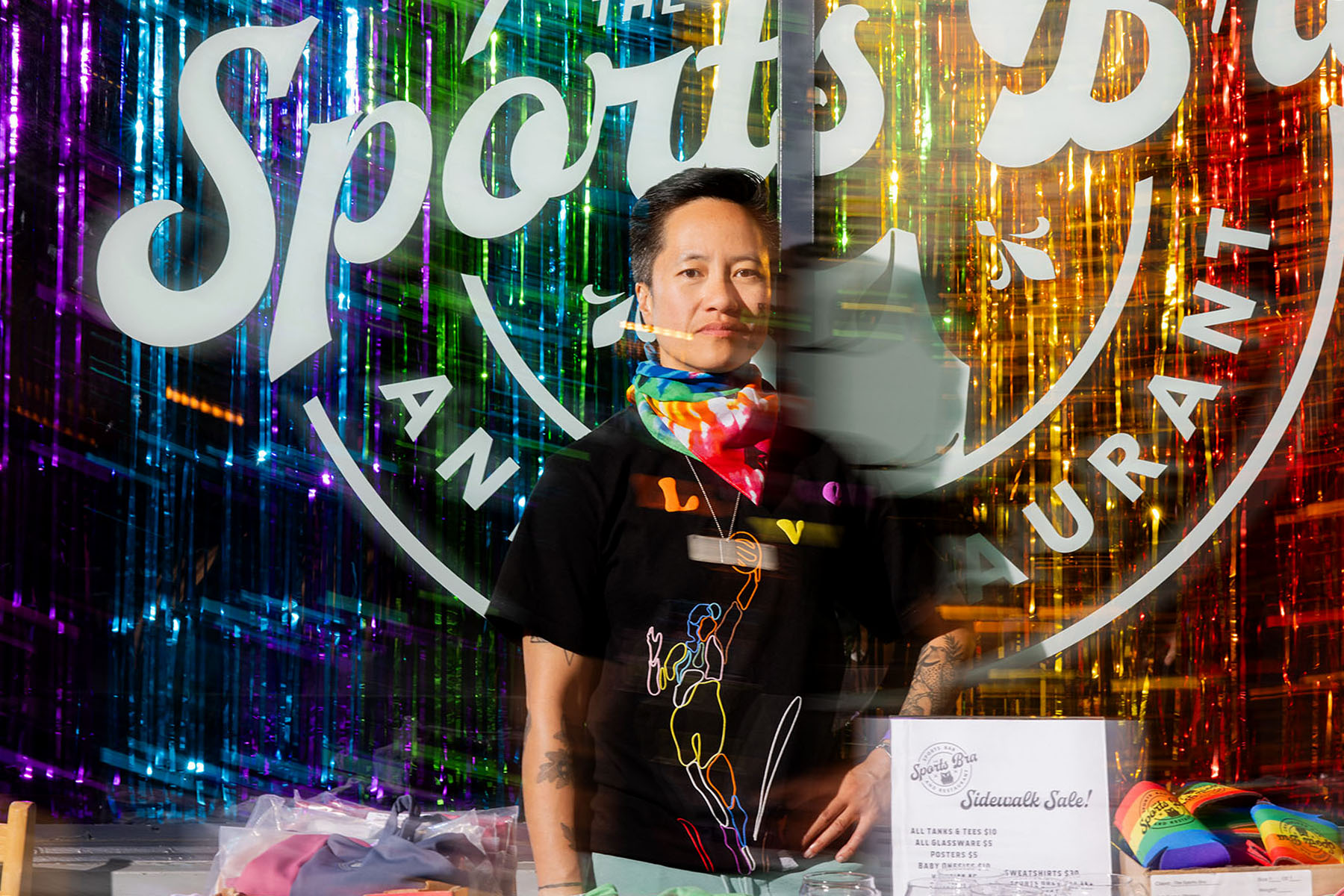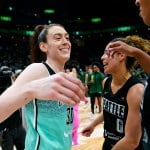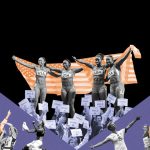The place was empty except for Jenny Nguyen and the cable guy, who had just finished hooking up the two TVs. Soon, this small room in Portland, Oregon, would be the nation’s first women’s sports bar. It would rarely know quiet like this again.
Nguyen flicked through the TV schedule and found two college women’s basketball games. She put one on each screen, and settled into a brown leather booth across from their twin glows.
It didn’t take long for the tears to come.
Nguyen, a former chef, had been playing with the idea of opening a bar dedicated to women’s sports since 2018. But she considered herself risk averse and pretty unambitious. She’d been unemployed for five years. And yet, once the idea took hold, she couldn’t quite shake it.
One night in 2021, she had been talking to a woman she was dating who, like Nguyen, had played basketball. (Nguyen played through high school until she tore her ACL at 19.) They envisioned a bar where the TVs only played women’s sports and no one batted an eye. It would be a place for families. How cool it would have been, they thought, to have had a place like that when they were kids or teenagers? What about now, in their 40s?
“We both realized that a space like that didn’t exist for us. When I thought about the young me, I thought, ‘God, if we can get one kid in here that could feel represented and feel like there’s a future for them in sports, even if that one kid had that moment, it would be worth it,’” Nguyen said.
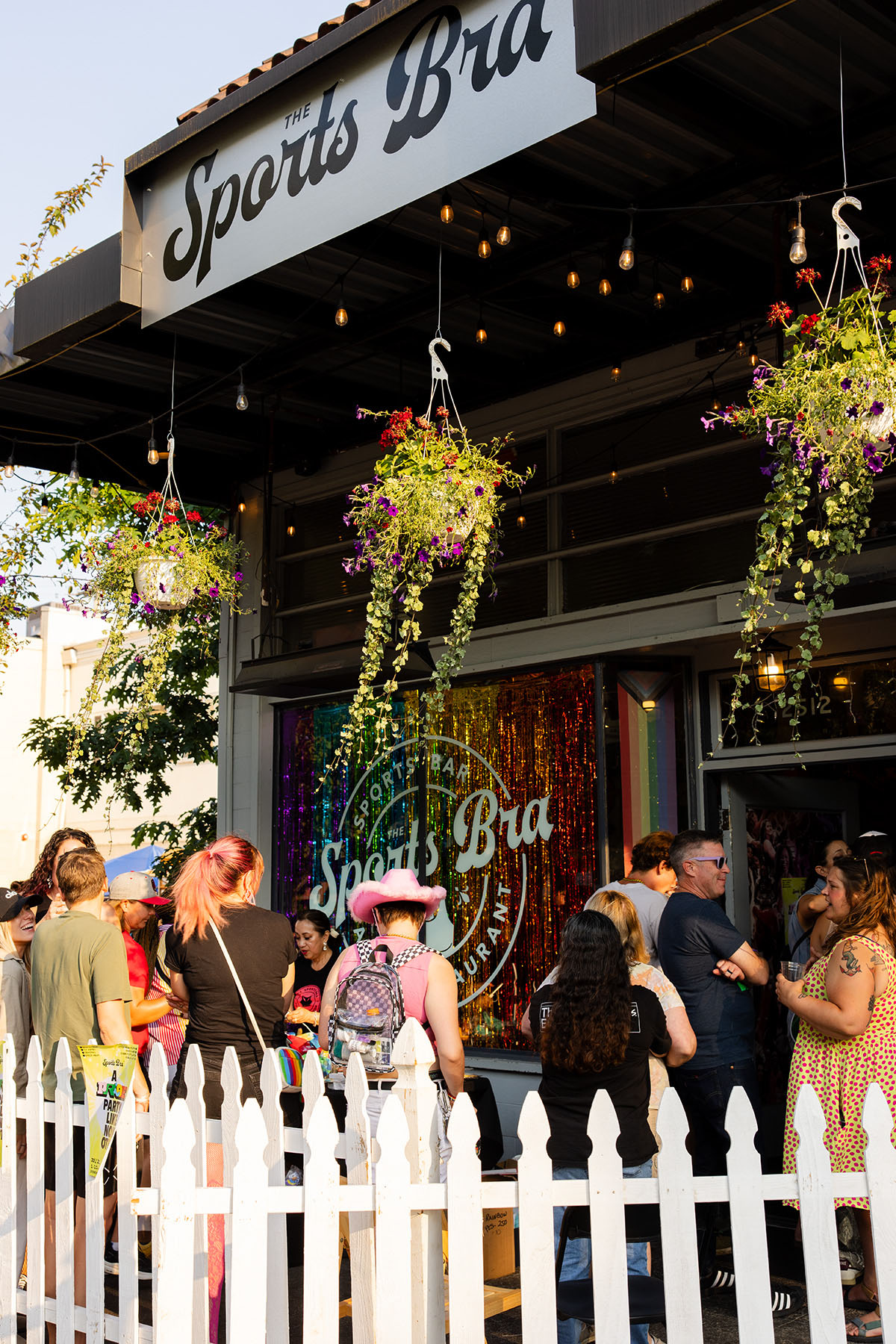
When Nguyen launched a Kickstarter campaign for the bar in February 2022, it was fully funded within nine days, ultimately racking up more than $105,000 from 600-plus donors. She found a spot in Portland’s Sullivan’s Gulch neighborhood next to a music shop. Inside, a bar ran along one end of the room and leather benches along the other. A basketball net chandelier hangs near a chalkboard menu listing 21 taps, all beers either made by women or at breweries owned or operated by women. Nguyen crafted a sophisticated bar menu (“Aunt Tina’s Vietna-wings,” a Vietnamese take on chicken wings, and a tempeh Reuben are on offer) and a cheeky cocktail list. The Title IX, one of their signature cocktails, is a mix of bourbon, peach liqueur and mint.
Around the entire room: scores of memorabilia — almost all donated — that pay homage to local and national teams. One of Nguyen’s favorites: a quilt of the iconic moment in 1999 when, after her penalty kick clinched the World Cup for the United States, Brandi Chastain ripped off her shirt and knelt on the turf in her sports bra.
When I thought about the young me, I thought, ‘God, if we can get one kid in here that could feel represented and feel like there’s a future for them in sports, even if that one kid had that moment, it would be worth it.’”
Jenny Nguyen
When “The Sports Bra” popped into Nguyen’s head, she was sure it was the name for her bar, even when people pushed back saying it was, somehow, too risqué. She just thought about it differently.
“I wouldn’t change much of what a sports bar is, but I would just change the channel on the TV. So I just took ‘sports bar’ and I switched the two letters,” she said. “The key is: The tiny changes make the biggest difference.”
As she sat before her two televisions, Nguyen recalled fighting to watch just one women’s basketball game at a bar — and to be thankful to view it even with the sound off. But now, here she was, in a bar she created, watching two women’s games at once — something so seemingly mundane that had been out of reach for so long.
Nguyen did not yet know that The Sports Bra would sprint its way to profitability, inspiring others to open nearly a dozen similar bars across the country. She did not know that “The Bra,” as patrons affectionately refer to it, would become a part of the evolution of women’s sports. That night, it was just the cable guy, Nguyen and her bar — almost to the finish line.
The Bra opened in April 2022, a 40-seat museum to women’s sports greatness. The front door is plastered with a mural of women athletes. Practically every available surface is lined with autographed jerseys, trophies, cleats and balls. WNBA Commissioner Cathy Engelbert signed the wall. On opening day, lines were out the door.
The Bra hit nearly $1 million in revenue in just eight months — a lightning-fast streak to profitability, especially for the hospitality industry. The bar’s success has been so monumental that it helped Portland win its bid to host the Women’s Final Four in 2030. Oregon U.S. Sen. Ron Wyden used it as the venue to pitch Engelbert on expanding the WNBA to Portland.
The Bra and Rough and Tumble, a women’s sports bar that opened in late 2022 in Seattle, have inspired the launch of similar bars in Long Beach, New York City, Minneapolis, Austin, Kansas City, San Francisco, Atlanta, Chicago and Denver. There’s at least one group chat for owners who are starting out.
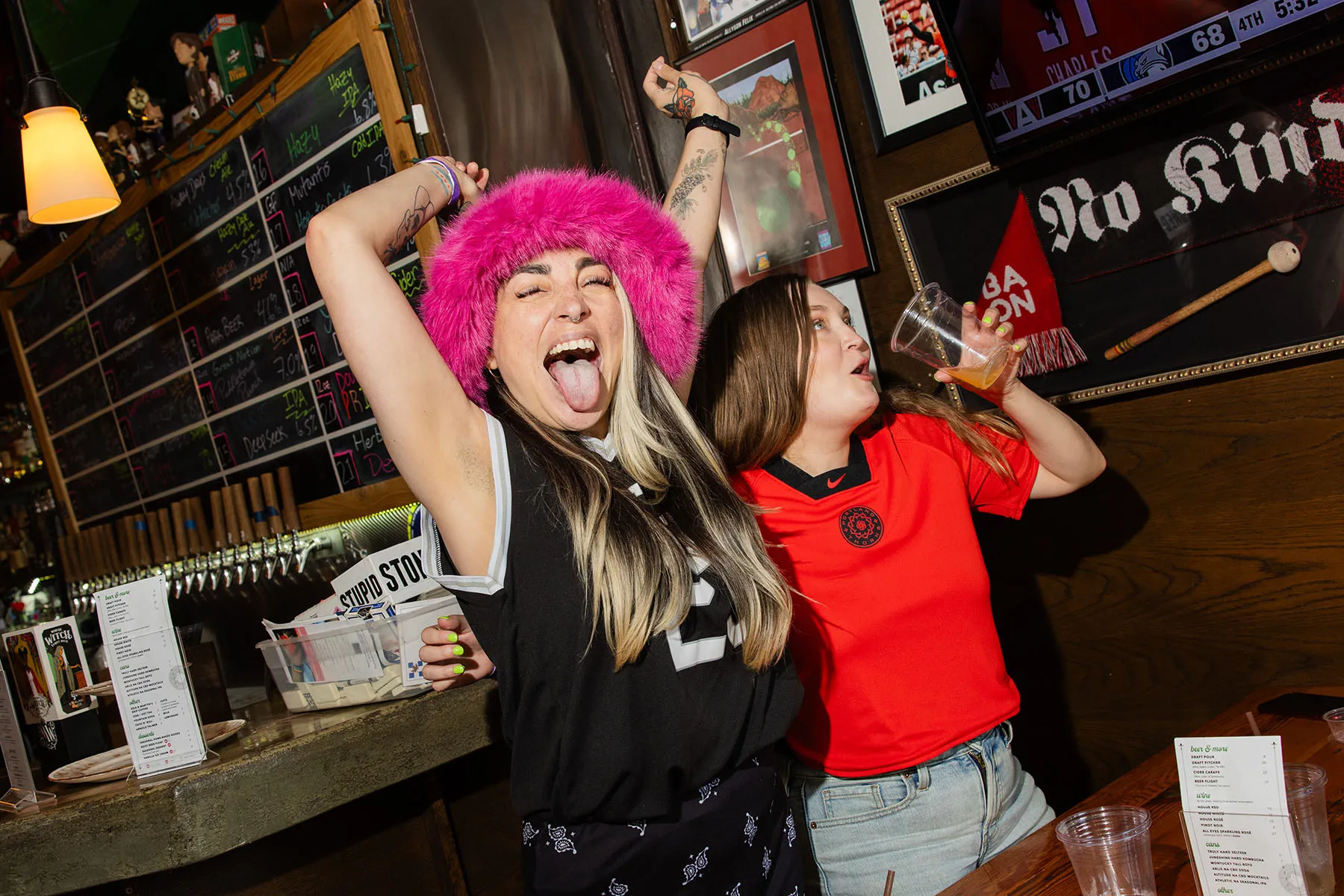
As The Bra has grown — there are now five TVs showing everything from roller derby to pickleball — its mission has expanded from being a place for women sports fans to also being a haven for the queer community (one poster declares, “Protect Trans Kids”), a place for people of color (a Black Lives Matter flag hangs over the bar) and for men. As Nguyen originally envisioned, kids are allowed until 10 p.m.
The Bra hosted a letter-writing campaign for Phoenix Mercury player Brittney Griner when she was detained in Russia, a Juneteenth showcase for Black women sports photographers, fundraisers for Planned Parenthood and a candlelight vigil for the victims of the shooting at Club Q, a queer nightclub in Colorado Springs.
Nguyen contracts with women-owned companies to supply food and drink for The Bra, propping up other proprietors in fields dominated by men. Portland distillery Freeland Spirits provides four of the cocktails on the menu. (Less than 8 percent of distilleries are owned at least in part by women, and it’s likely that fewer are solely women-owned.) Carman Ranch provides the grass-fed beef. (About 9 percent of farms are run entirely by women.)
The bar has symbolized other things she didn’t expect, too. Nguyen is Vietnamese, but said she grew up with some shame about her background, always trying to be American enough. But opening The Bra has helped her reconnect with those roots, particularly after she saw how eagerly her community embraced the venture.
“I had people who were Vietnamese women business owners — they were very moved by what we are doing here. That is not something that had crossed my mind, that I was a Vietnamese woman opening a sports bar,” Nguyen said. “Once I realized the power of what we were doing here, it made being intentional about things a very high priority.”
Every inch of those walls was covered in women’s success. Normally we have an inch, we have a back hallway, we have a strip of something. This is every inch.”
Erin Gallagher
The Bra is the kind of idea many women’s sports fans say they wish they’d had. In fact, Nguyen estimates that six or seven people have told her they’d had an idea for a bar with the same name. The difference, of course, is that she acted on it, and did so at a pivotal moment: Deloitte estimates women’s sports will surpass $1 billion in global revenue this year.
“What I love about [The Sports Bra] is it’s in your face, in that you can witness the success and the popularity and the excitement. And if you’re a naysayer, sit back and go, ‘Oh, there’s actually something here,’” said Alicia Jessop, a sports industry expert who founded the sports business website RulingSports.com.
Particularly in the past three years, Jessop said, social media has allowed athletes to circumvent the limitations of broadcast media to create their own followings. New rules regarding name, image and likeness compensation for NCAA athletes have allowed them to earn money from endorsements, and the number of women scoring those deals soared during the 2023-2024 season.
“The powder in the keg is getting ready to explode,” said Jessop, now an associate professor at Pepperdine University, about the popularity of women’s sports. “This train is off and it is moving and it is moving quick — it’s getting to the point where you need to hop on because it’s going to be gone.”
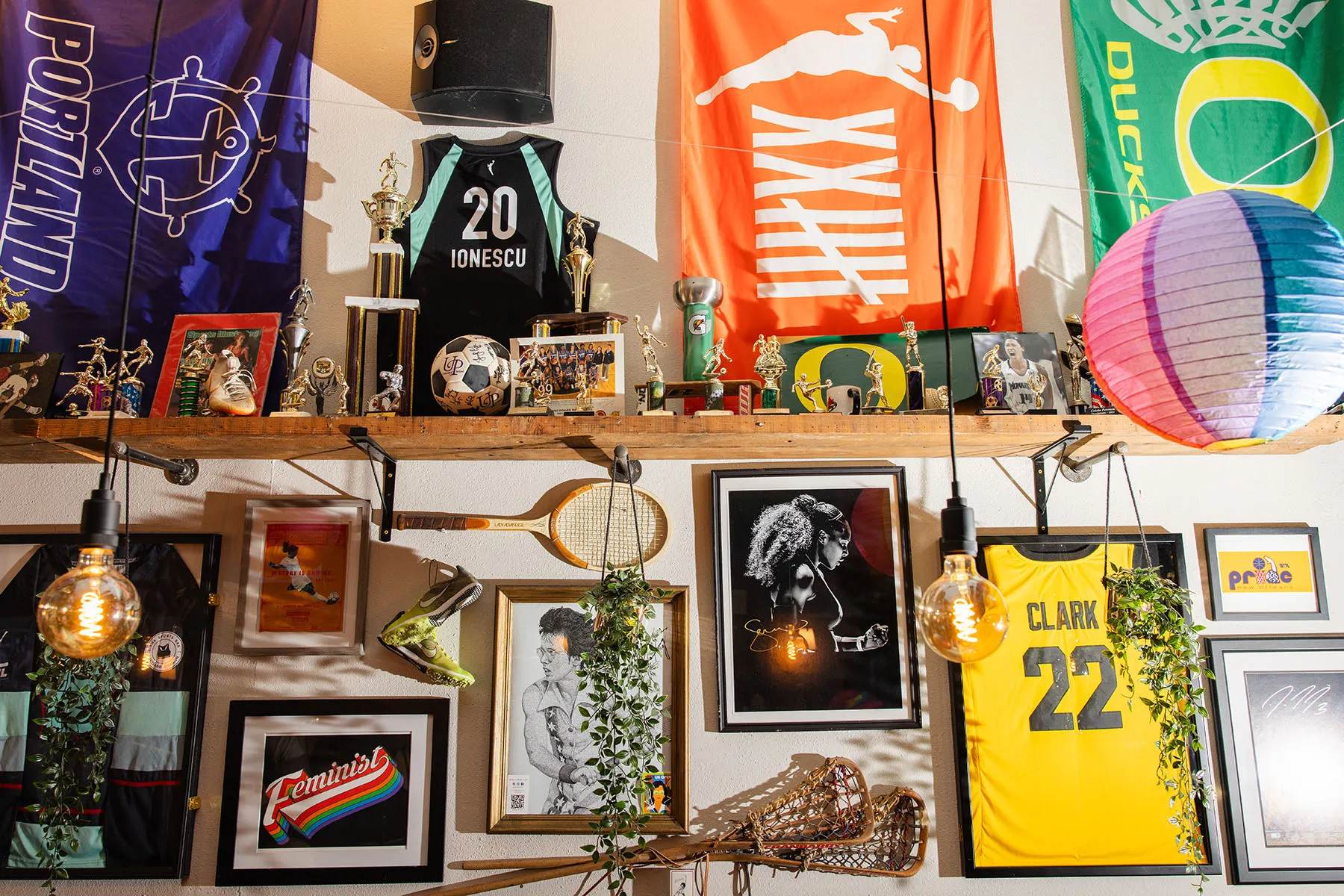
Like most customers, Erin Gallagher has a story about the first time she stepped inside The Sports Bra. A lifelong soccer player and two-time founder, Gallagher was moved by Nguyen’s story. “I’m always really drawn to women who decide to take an idea and do something with it. I understand on a visceral level the fear of doing that,” said Gallagher, the founder of Ella, a network for women leaders and entrepreneurs that provides consulting and help with access to capital.
She spent her first half-hour there last month just taking in all the memorabilia, from floor to ceiling. Big things, like a jersey signed by breakout basketball star Caitlin Clark, and little things, like kids’ sports trophies. Her eyes landed on a jersey signed by Mia Hamm, the ‘90s soccer star — and Gallagher’s childhood idol.
“Every inch of those walls was covered in women’s success,” Gallagher said. “Normally we have an inch, we have a back hallway, we have a strip of something. This is every inch.”
Women’s sports and The Bra’s winning streak have fueled each other.
For most of their history, women’s professional teams and their fan bases have been much smaller than those of their male counterparts. The WNBA was founded in 1996 and today has 12 teams compared to the NBA’s 30. A smaller WNBA fan base led to smaller player deals and less revenue from tickets, merchandise and broadcast rights. The 2022-2023 season drew 22.2 million fans to NBA games and about $10 billion in revenue, while the WNBA drew 1.6 million fans and about $200 million in revenue.
Player pay is based on a league’s revenue, and since the WNBA is many times less profitable than the NBA, that has led to disparities in what top players are paid. WNBA players are also entitled to a smaller share of revenue overall. About 50 percent of the NBA’s revenue is spent on salaries, a result of the players’ bargaining power, which has amassed over decades and ensured better contracts. In the WNBA, only 10 percent of league revenue is reserved for player pay.
That means that Caitlin Clark, whose impressive rise as a point guard at the University of Iowa earned her a spot among the best college basketball players of all time, will be paid $76,535 as the top WNBA draft pick by the Indiana Fever. In the NBA, the No. 1 draft pick, Zaccharie Risacher, will be paid $12.6 million — 165 times more.
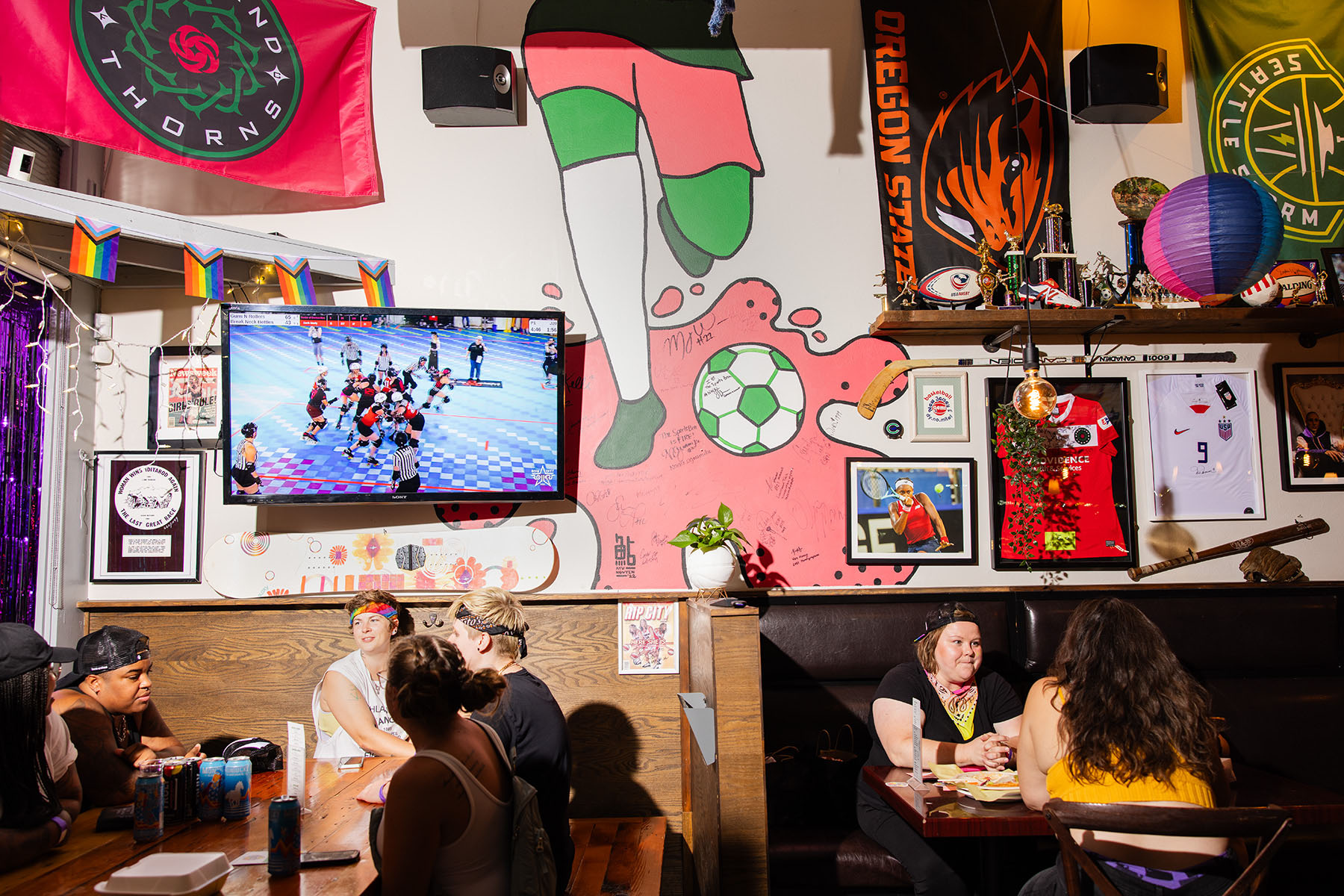
In soccer, players in the National Women’s Soccer League top out at about $400,000 a year, but salaries for Major League Soccer reach as high as $20.4 million. The United States Soccer Federation, which oversees both leagues, also sends men’s and women’s teams to compete in World Cup tournaments. It took a six-year battle for athletes on the U.S. women’s national team to begin earning the same as men, even though the women have four World Cup titles and four Olympic gold medals, and the men have none.
Overall, women’s sports get only about 15 percent of all airtime — a jump from three decades of commanding just 5 percent of airtime. But that still means fans have to work harder to watch their teams. A recent study by sports marketing researchers found that one of the key differences between WNBA and NBA fans is that women’s basketball fans often watch alone. More than 1 in 4 WNBA fans said they have no one to watch or go to games with, or even talk to about the league. In other words, they lack the camaraderie that fuels fandom. Men’s sports have had that for years thanks, in part, to sports bars.
Creating a bar where you have fans coming into a space and you have a sporting event on and they’re now interacting with each other — that is a huge part of the fan experience that didn’t exist before.”
David Berri
“Creating a bar where you have fans coming into a space and you have a sporting event on and they’re now interacting with each other — that is a huge part of the fan experience that didn’t exist before. It illustrates your fan base has gotten big enough for that to happen,” said David Berri, a professor of economics at Southern Utah University.
Still, he points out, when men’s sports were starting out, they didn’t have much of a fan base either. People forget that, said Berri, who is also co-author of the upcoming book, “Slaying the Trolls! Why the Trolls are Very, Very Wrong About Women and Sports.” In the early years of the NBA, attendance was so poor that Maurice Podoloff, the league’s first president, told team owners in 1949, “If you can avoid giving the figures out, do so. If however, you must announce figures, a little padding will be forgiven.”
Berri notes that the NBA has been around for 75 years, while the WNBA is only 28 years old. Yet the WNBA is on the same growth trajectory as the men’s league, given its age, he said. And next year, the WNBA union contract will be up for renewal, which could help improve payment structures.
The NBA, which owns 60 percent of the women’s league, reportedly just secured a $200 million annual media rights deal for the WNBA — up from $60 million a year — that could help improve pay. But Terri Jackson, the executive director of the players’ union, called it an undervaluation after an electrifying few years for women’s sports. This year, the NCAA women’s basketball championship between Iowa and South Carolina drew 18.9 million viewers on average, surpassing viewership for the men’s final. The WNBA draft drew 2.45 million, another record.
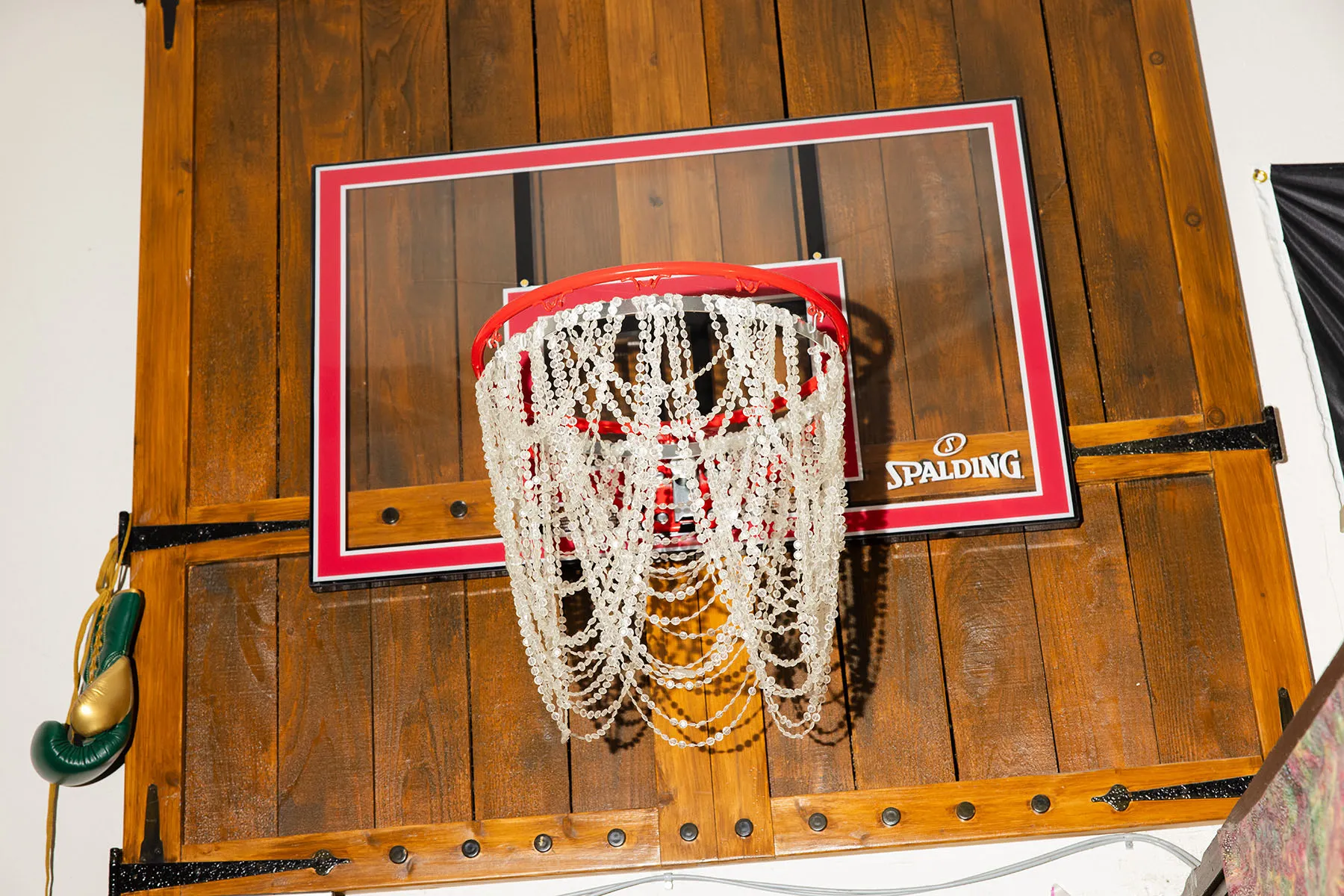
In 2023, the Women’s World Cup also hit an all-time attendance record. That year, the National Women’s Soccer League secured the largest-ever media deal in women’s sports at $240 million — more than 50 times the previous deal.
The Olympics will be another opportunity to prove that point. Historically, women’s sports are among the most-watched — gymnastics and figure skating, especially the women’s competitions, top the Summer and Winter Games, respectively.
The Sports Bra definitely won’t be missing the moment. Earlier this year, Alexis Ohanian, Reddit co-founder and the husband of tennis champion Serena Williams, considered by many one of the best athletes of all time, announced that his foundation would invest in The Sports Bra as it ventures into franchising. “Hundreds upon hundreds” of inquiries have poured in from fans who want to have a Sports Bra in their own cities, Nguyen said.
She said she hopes to open franchise applications this summer, and her focus will be on finding owners who are connected to their communities, who can bring her vision for The Bra to their hometowns.
It won’t be easy. Expansion is costly, and The Bra has been spending a significant amount preparing to franchise. Revenue has stayed about steady but hasn’t topped that explosive — albeit unsustainable — start.
But in some ways, Nguyen already knows the franchises can be successful. That’s because other sports bars that have tried to recreate the magic of The Bra have already proven it.
Jillian Hiscock has a story about her first time at The Sports Bra, too. She was visiting Portland from Minneapolis, and on her second night at The Bra, a mom entered with two young girls in their tiny soccer practice outfits. As the mom waited at the bar, the girls looked around, their eyes bulging as they took in all the images of women sports heroes.
“That is going to be normal for them,” Hiscock realized, “to see women prioritized at that level.”
Hiscock previously worked in college admissions. She had no bar experience. But after that trip, she decided to open her own spot. Much like Nguyen, she was able to quickly fundraise: $205,000 from 40 states and four countries. In March, she opened A Bar of Their Own, named after the 1992 film about an all-women baseball league, “A League of Their Own.”
The bar offers gluten-free and vegan food. It carries non-alcoholic drink options. It has accessible seating for people with disabilities. It has gender-neutral bathrooms. Almost every business Hiscock has worked with is owned by a woman, a transgender person or a nonbinary person, from the construction company and the painters to the drinks vendors. Seventeen of the 18 tap lines are from breweries that are women-, trans- or nonbinary-owned, each delineated with a star on the menu. The bar also works with Freeland Spirits, the same Portland company The Bra does.
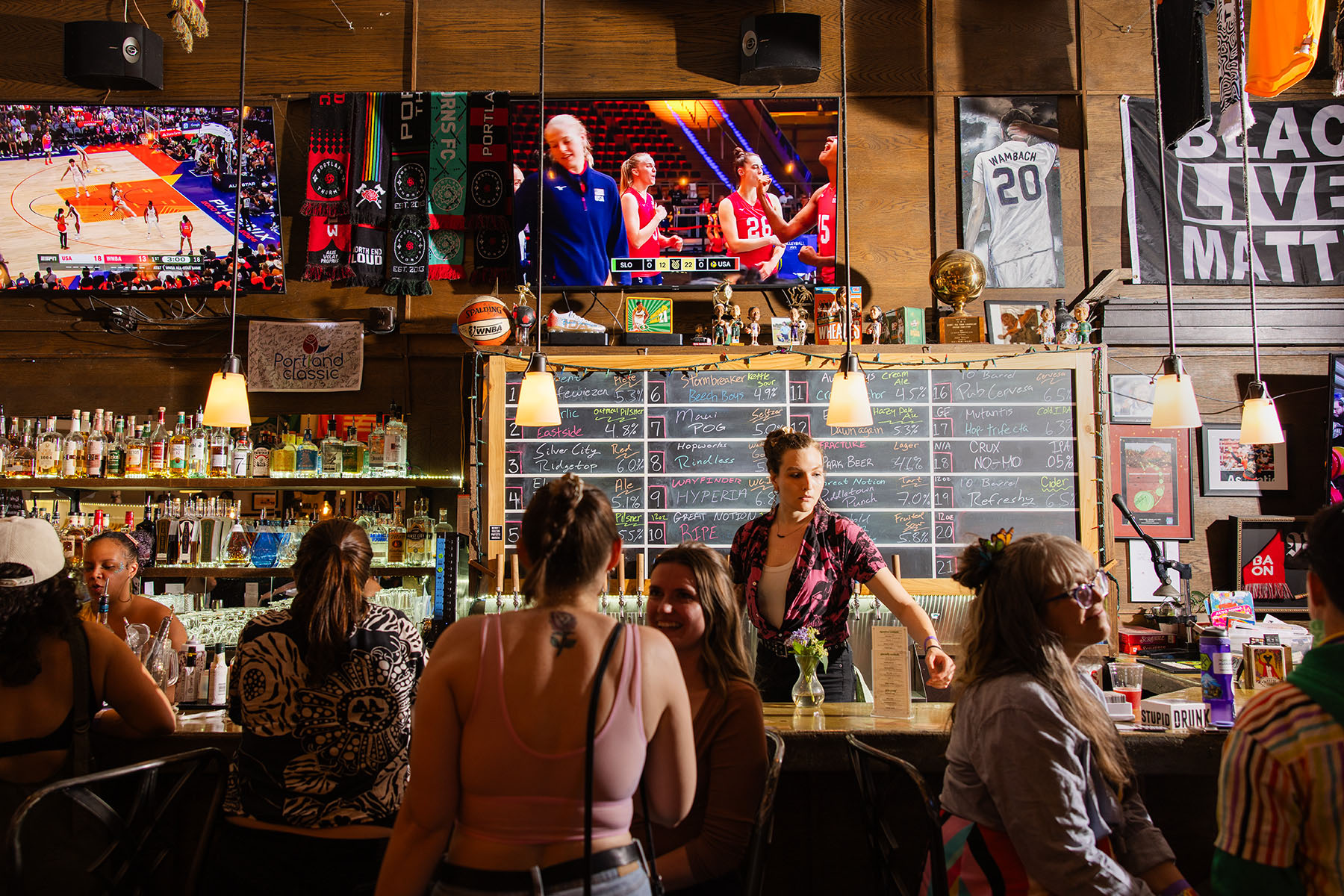
Nguyen, who has served as an unofficial consultant on many of the newer bars, offered her tips for Hiscock: Stick to your guns — make the place what you want it to be. And stop every once in a while to take it in.
Taking a stand hasn’t been hard for Hiscock, who says she’s always had “strong opinions.” She remembers beer reps telling her she wouldn’t be successful if she didn’t sell Michelob and Miller Lite — the two most popular beers at sports bars.
“What’s the number-one-selling beer at women’s sports bars?” she asked them.
Crickets.
“OK, well, I’ll tell you in a year once we’re open and we’ll go from there,” she said. (The favorite so far, by the way, is the Shortstop Pils, which was made for the bar by Urban Growler Brewing, a queer women-owned brewery in St. Paul.)
That is going to be normal for them — to see women prioritized at that level.”
Jillian Hiscock
Not long ago, someone slapped a sticker to the front door of the bar that read, “Keep female sports female” — part of the call to keep trans women out of women’s sports. In response, for Pride, the bar staff made koozies that read: “Let trans kids play.”
In Austin, Debra Hallum and Marlene du Plessis are preparing to open their own place later this year. They’re calling it ATX Women’s Sports Pub. Like Hiscock, the co-founders don’t have a bar background — Hallum worked in telecommunications and du Plessis in educational leadership. But they are fans who also took a trip to a women’s sports bar, Seattle’s Rough and Tumble, and came back transformed. They rely on a text group chat that includes the owners of the other bars that are just starting out to answer questions, like about how to stream women’s sports and how to do pop-up events.
Like the others, they’re taking an intentional approach to their establishment. For one, it’ll be a pub, not a bar, because they feel “pub” connotes more of a family space, said du Plessis, who is from South Africa. They also want it to be a place for LGBTQ+ people and for men. They hope ATX Women’s Sports Pub will host fundraisers for local women’s teams, and opportunities for residents to meet the players.
“If we have a youth league in Austin who needs some kind of assistance, we want to make sure girls get to play what they want to play. If a girl cannot afford her uniform, we want our community to be thriving so well that we either find a way to help them get that uniform or, as a business, we cover that uniform,” Hallum said. “There are so many things we want to make sure we’re helping with.”
In Minneapolis, A Bar of Their Own has now been open for four months. Most days, it’s pretty busy. At the end of a long day, Hiscock likes to pull up a chair with her wife and drink a beer — not Michelob or Miller Lite. The walls there also have stories. Tennis legend Billie Jean King signed one of them. The woman who runs the construction company Hiscock used donated an entire shadowbox of memorabilia. Turns out, she was on the first-ever U.S. women’s rugby team. The bar even has some souvenirs from the USA women’s bandy team — a quirky, little-known combination of ice hockey, field hockey and soccer.
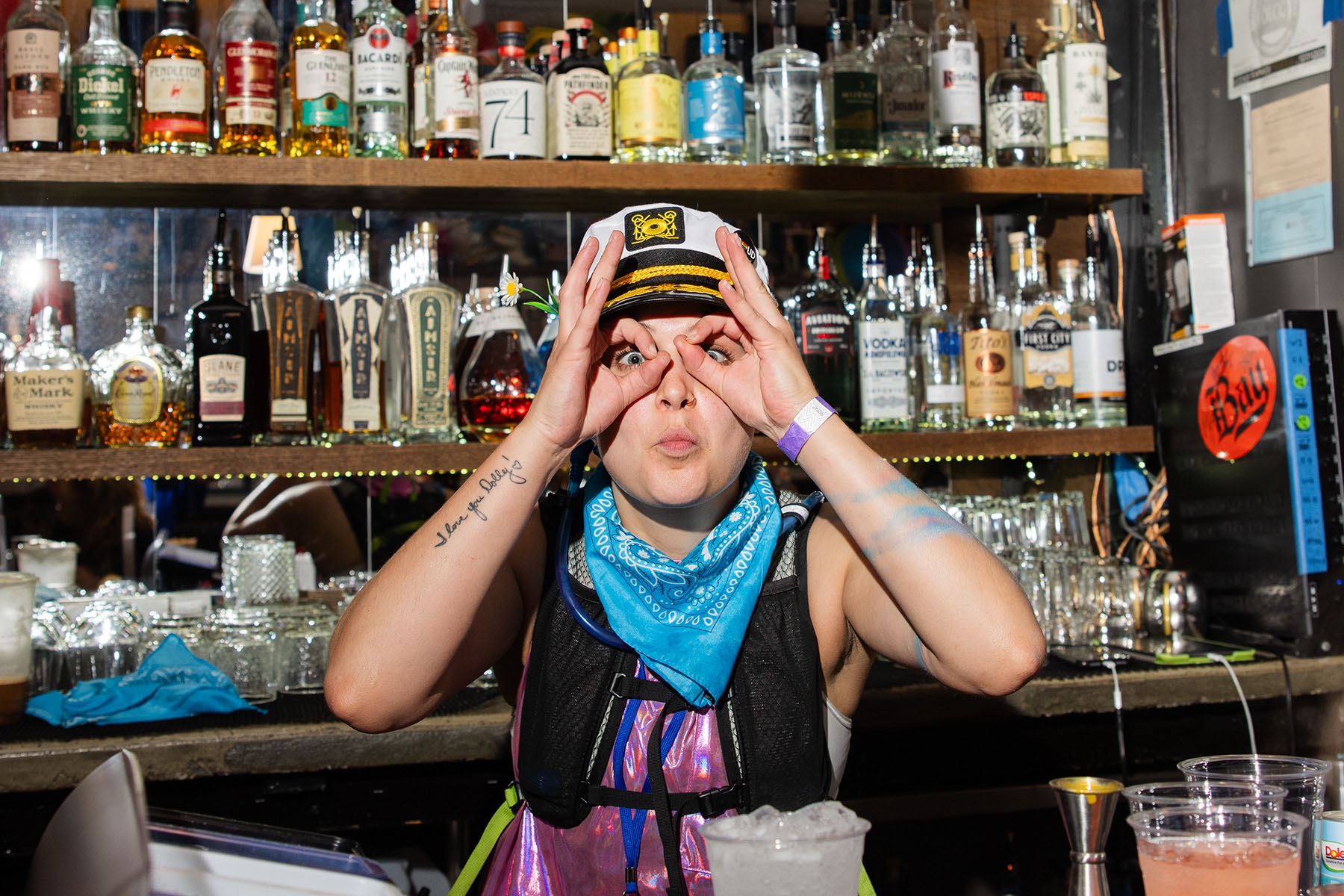
It has always nagged Hiscock that while most people can recognize some NFL quarterbacks or name the teams that recently played in the Super Bowl, it’s been impossible to be a casual women’s sports fan. If you want to follow a team you love, she likes to say, you need a “master’s degree in streaming services.”
Now, she’s watching that change. Not too long ago, a family with two little boys came into the bar, and one of the boys got wrapped up watching a Tennessee Lady Volunteers basketball game. He’d never watched women’s sports in his life, his mom told Hiscock. Honestly, what he probably liked was that the team wore his favorite color: orange.
But Hiscock has seen the family come in a few times now — and learned that the little boy asked for a Vols shirt for his birthday.
“This is what his norm is going to be,” Hiscock said. “Now there’s this little boy running around with the Volunteers’ women’s basketball shirt that he has no connection to — other than he saw it at A Bar of Their Own.”
When Serena Williams played her final match at the U.S. Open in September 2022, The Sports Bra had been open just five months. Nguyen threw every rule about seating capacity out the door so that as many fans as possible could stand shoulder to shoulder.
As Williams took on Ajla Tomljanović, fans stuck outside cupped their hands to the glass to catch whatever glimpse they could of the match.
“Someone flipped a burger and you could hear it sizzling,” Nguyen said. “When Serena would score a point, it felt like the glass was gonna break.”
When Williams lost, Nguyen passed out boxes of Kleenex.
She looked around and thought: I don’t think this moment is happening anywhere other than here. And maybe at the U.S. Open in New York. Maybe.
Two weeks later, a woman who had been at the U.S. Open came by to drop off some memorabilia.
“Guess what?” the woman asked her.
What?
“While I was watching Serena Williams play her last match, I wondered what it was like at The Bra.”
